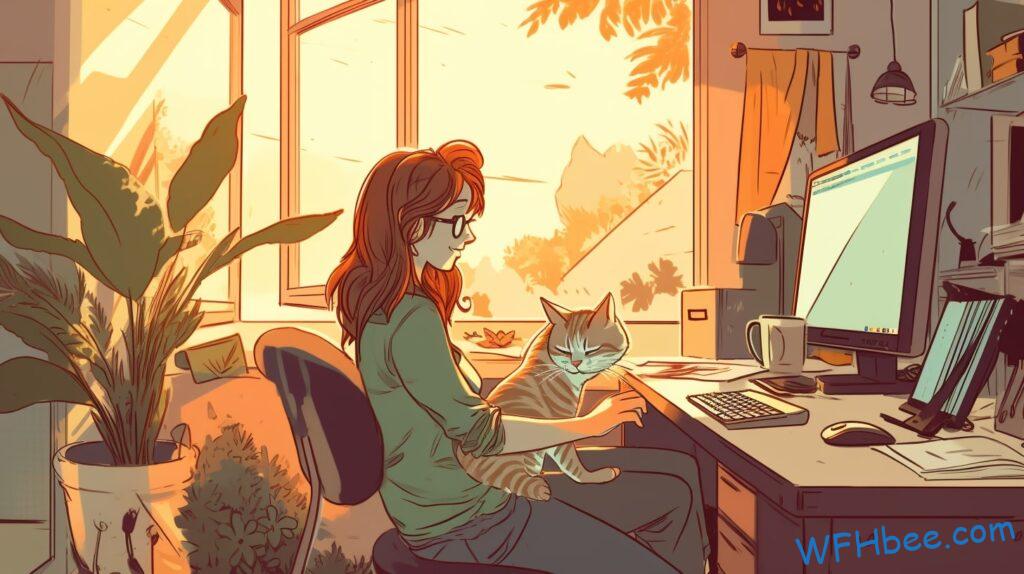Working from home can be a great way to find balance in life and enjoy more flexibility. However, when you add in a furry companion like a cat, it can become difficult to stay focused on the task at hand. Have no fear! We’ve got some useful tips for anyone looking to work productively with their feline friend around.
For many of us, our cats are not just pets; they’re part of the family — so having them near while we work is important. But how do you make sure your cat doesn’t turn into an unwelcome distraction? We’ll show you how to balance working from home without compromising your productivity or quality time with your pet.
You don’t have to give up all hope of staying productive if you’ve got a kitty corner office mate! With these helpful tips, you can learn how to keep both yourself and your cat happy and comfortable during those long hours spent working from home. So grab a cup of coffee (or tea!) and let’s get started!

Table of Contents

Benefits Of Working From Home With A Cat
Working from home with a cat has many benefits. Not only can feline companionship help reduce stress and improve mental health, but it also encourages productivity and creativity. One of the most significant advantages of working from home is that you get to enjoy your own space without feeling like you’re competing for attention or recognition. You don’t have to worry about office politics or rushing to get projects done on time since you can take your time and do things in your own way. Plus, cats are great at keeping us company during long days spent indoors – sometimes their presence alone can be enough to bring up our moods!
Having a comfortable workspace is essential for making sure you stay productive while enjoying all the perks of having an animal companion around.

Creating A Comfortable Workspace
Creating a comfortable workspace for yourself and your cat is essential for successful work-from-home productivity. Cat-proofing the space should be top priority to ensure your valuable items are safe from destruction and that cords, wires, and other hazards are out of reach. After clearing away any potential danger zones, it’s time to make sure you have all the right furniture. Ergonomic chairs and desks will help keep you in good physical shape while working long hours at home. Additionally, soundproofing measures like noise cancelling curtains or acoustic foam panels can help separate work life from home life.
A comfortable workspace also means taking into account your pet’s needs as well. Make sure they have their own bed near yours so they don’t feel left out when you’re busy on conference calls. Have some toys around too – cats always appreciate having something exciting to play with! A window seat nearby where they can take in some sunrays would be ideal if possible, as cats love gazing outside. With these small touches, both humans working virtually and animal companions alike can stay relaxed and content during those long days spent indoors together.

Establishing Boundaries With Your Cat
When it comes to working from home with your cat, setting boundaries is essential. Not only will this help you stay focused on work tasks and minimize distractions but also keep your cat safe. Establishing clear boundaries between where they can go during the day and where they are not allowed helps create a sense of order in your workspace as well as train them to respect limits.
The first step in establishing boundaries for cats is physical barriers: using gates, baby-proof locks, or closed doors that limit access to certain areas of the house. This could be anywhere from one room that’s designated for work purposes only to more specific spaces like the desk area itself. Make sure these physical boundaries are consistently enforced so there’s no confusion about what ‘off-limits’ means. It may take some time for your cat to get used to their new limits, but remain firm and consistent – rewards such as treats can help reinforce good behavior!
Another important aspect of boundary setting involves limiting contact while you’re trying to focus on work tasks. That means managing interactions by providing plenty of playtime before and after work hours when your attention won’t be divided between petting/playing with them and meeting deadlines. Creating an off-limit zone around the desk space ensures that both activities can coexist without distraction; alternatively, set up a ‘workstation’ nearby if possible so that neither party has to feel ignored or neglected throughout the day.
With these tips in mind, you can easily transition into a successful routine of working from home with your furry friend – while still maintaining healthy boundaries between yourself and your pet!

Managing Distractions
Distractions can be a huge roadblock to working from home with your cat. The key is distraction management; reducing and preventing distractions as much as possible.
First, reduce the amount of time that you are distracted by having an organized workspace. Make sure only necessary items are on your desk so that there isn’t anything tempting for you or your pet to play with. Also keep any food out of sight and reach, otherwise it could become quite distracting!
Second, prevent potential distractions before they happen. Be mindful about where you put cords and wires in order to avoid them becoming chew toys for your cat. Ensure windows and doors are closed when needed so that no birds or squirrels enter uninvited into your work space. And consider using noise-canceling headphones if outside noises start to overwhelm you while trying to concentrate.
Lastly, try setting up specific times during the day when playing with your cat is allowed – this will help minimize unnecessary interruptions throughout the day which may take away focus from getting tasks done efficiently. With these tips in mind, transitioning into the next section about setting up a routine for your cat should be smoother..

Setting Up A Routine For Your Cat
“A stitch in time saves nine.” Creating a routine for your cat is essential to help them acclimate to the daily changes of working from home. Cats are creatures of habit and need consistency, so establishing a day-to-day schedule will make it easier for both you and your furry companion.
First, figure out when you’ll be able to spend quality one-on-one time with your cat during the workday. This could include everything from cuddle sessions on the sofa to interactive playtime with their favorite toys. Make sure this happens at the same time each day; cats love predictability! Having a consistent feline routine helps build trust between you and your pet while also providing mental stimulation that can prevent boredom.
Next, consider setting aside regular exercise periods throughout the day where your kitty can get up and move around as they please. An hour or two spent outdoors (depending on if there are any nearby hazards) provides an ideal opportunity for physical activity that’s safe yet stimulating. You can also create designated indoor spaces just for them, such as a window perch or scratching post area in which they can explore and relax without restrictions.
By taking these steps, you’ll not only give your cat much needed structure but provide yourself peace of mind knowing that they’re well taken care of while you’re away. With a reliable schedule established, addressing separation anxiety becomes simpler — allowing everyone involved to enjoy their new normal more fully!

Addressing Separation Anxiety Of Cat In Remote Setting
Separation anxiety can be a real issue for cats when their owners are working from home. To address this, it is important to set aside time each day for your cat and give them plenty of love and attention. You should also provide them with toys or other items that help keep them entertained while you’re away. This could include things like scratching posts, treat-dispensing puzzles, or even interactive laser pointers.
When left alone for long periods of time, cats may become stressed out due to the lack of stimulation or interaction with their owner. Make sure that you have a routine in place so your cat knows what to expect during the day and has something positive to look forward to. Taking regular breaks throughout the day will help alleviate some of the stress they feel by providing mental stimulation as well as physical activity through playtime. Additionally, make sure your cat feels secure by offering hiding places around the house such as beds or cardboard boxes that they can crawl into if needed.
Finally, there are many products on the market designed specifically to reduce feline separation anxiety such as plug-in diffusers which emit calming pheromones or white noise machines which mask outside sounds and provide additional comfort while you’re away. By taking these steps and understanding feline behavior, you can ensure both yourself and your pet remain happy and relaxed during work hours from home. Keeping your cat entertained is key for maintaining an optimal living environment for both parties involved.

Keeping Your Cat Entertained
Cats need lots of stimulation to keep them mentally and physically healthy. To keep your cat entertained while you’re working, there are a few things you can do. Cat toys are essential for keeping cats occupied; choose toys that stimulate their natural hunting instincts like interactive feather wands or puzzle feeders. Environmental enrichment activities such as hiding treats around the house or using empty cardboard boxes or paper bags will help engage your cat’s curiosity. Interactive games such as chasing laser pointers, teaching tricks, and playing fetch with stuffed animals can also be fun ways to bond with your furry friend. Having something engaging for your cat to do during the day is key in making sure they don’t become bored and destructive- behaviors which could distract you from getting work done!
With all this playtime comes messes that need cleaning up afterwards – it’s time to talk about maintaining a clean work environment!

Maintaining A Clean Work Environment
Maintaining a clean work environment is essential when you work from home with a cat. Keeping your pet and workspace tidy will ensure that neither of you becomes overwhelmed by clutter. The following are some useful tips for keeping your workspace clean:
- Cat-proofing: Be sure to secure any cords or cables that may be accessible to prying paws, as cats tend to play with them regularly. This can also avoid potential damage to your devices.
- Litter-box: It’s important to keep the litter box tucked away in an area where it won’t disrupt your workflow; this will help contain odors and reduce distractions.
- Pet-proofing: Remove small items such as paperclips, rubber bands, etc., from areas close to where your cat has access – they could accidentally swallow these items and become ill if ingested.
- Regular Cleaning Routine: Establish a regular cleaning routine on top of daily tidying up – vacuuming carpets, dusting surfaces, washing bedding materials weekly – all of which helps maintain both yours and your cat’s hygiene levels.
By taking steps now to create a clean workspace, you’ll save yourself time later on trying to clear messes resulting from curious kitty antics! Knowing how much energy cats have makes it easier to understand why they might try exploring different things around their environment – so educating yourself on feline behavior can be beneficial too. With these tips in mind, you can enjoy working from home while giving your furry friend the attention he deserves!

Educating Yourself On Feline Behavior
Learning about feline behavior is an essential part of working from home with a cat. Understanding cats requires knowledge of their psychology and how they interact with the world around them. To this end, there are several resources available for anyone interested in educating themselves on cat behavior.
Books that cover topics such as body language, communication styles, play behaviors, and social skills can be invaluable when trying to understand your pet’s needs or preferences. Additionally, websites such as The Cat Behavior Clinic provide information on common issues like separation anxiety or aggression which can help you better manage any behavioral problems your cat may have.
It’s also important to stay up-to-date on the latest research regarding cats so you can continue to learn more about their unique characteristics and personalities. Reading articles online or attending seminars can both help broaden your understanding of cats and give you better insight into how best to care for yours.
This knowledge will come in handy as you move onto accommodating the needs of an elderly or disabled cat while still managing work at home.

Accommodating The Needs Of An Elderly Or Disabled Cat
While educating yourself on feline behavior is an important step in working from home with a cat, it’s also essential to understand the special needs of elderly or disabled cats. As cats age, their physical and mental abilities can decline, making them more prone to disease and injury. Likewise, for cats that are born with a disability or sustain an accident later in life, they may require extra care in order to remain healthy and happy. Here are some useful tips when caring for elderly or disabled cats:
- Provide extra warmth – Elderly and disabled cats often have trouble regulating their body temperature due to reduced muscle mass. Providing your cat with heated beds and blankets will help keep her cozy during cold winter months.
- Help your cat get around – For cats who cannot move as quickly as before, create ramps, steps, or other aids that make getting around easier. Additionally, if you must carry your cat up stairs or down halls be sure to do so gently but firmly so she does not feel scared or overwhelmed by the motion.
- Monitor food intake – Many older cats need fewer calories than younger ones; however it’s still important to provide high-quality nutrition tailored specifically for seniors’ dietary needs (including plenty of water). Additionally, since some disabled cats cannot eat dry food easily consider wet foods instead which are softer and easier for them to digest.
By understanding the unique needs of elderly and disabled cats we can ensure our furry friends stay safe and comfortable while living at home with us! Caring for aggressive or destructive cats requires different approaches such as providing appropriate outlets like scratching posts or toys designed to redirect negative energy into positive playtime experiences.

Dealing With Aggressive Or Destructive Cats
It’s important to understand why cats may become aggressive or destructive. Feline behavior can range from rubbing and purring contentedly, to hissing and scratching aggressively. If your cat is displaying aggression or destruction, it could be due to a combination of stressors such as changes in the environment and boredom.
The first step towards solving this problem is identifying potential triggers that are causing your cat’s distress. Perhaps they don’t like being disturbed when sleeping, or feel threatened by certain noises coming from outside the home. By understanding what causes them discomfort, you can take measures to reduce their anxiety levels by providing an enriched environment with plenty of hiding places and toys for stimulation.
Another way to help manage feline behavior issues is through positive reinforcement training techniques such as clicker training. This type of training helps build trust between you and your pet while also teaching them good habits that will make living together easier in the long-term. With patience and consistency, these behaviors can become second nature for both you and your furry friend!
By taking steps to prevent misbehavior before it starts, you’ll create a harmonious relationship with your beloved cat even if working from home isn’t always easy. When unexpected emergencies occur, having a plan in place will ensure both of you remain safe during stressful times.

Preparing For Unexpected Emergencies
As darkness falls, it is important to be prepared for unexpected emergencies. Not only does this apply to our lives outside of the home, but also at home when we are working with a cat around us. It’s essential to have an emergency plan in place that allows you and your pet to remain safe should anything happen while you’re working from home.
The first step in preparing for any unexpected emergencies is having resources ready in case of an emergency. This could include food, water, litter boxes or other supplies needed on short notice. Additionally, make sure that all contact information such as veterinary records and microchip details are updated and accessible if necessary.
It’s wise to consider some sort of backup power source like a generator or battery-operated fan – just in case there is an electrical outage during extreme weather conditions. Emergency preparedness can also involve taking into account special needs cats might have due to age or medical condition; such as medications that need refilling before running out unexpectedly or additional items required for their care.
Having access to these resources not only helps ensure safety and security for everyone involved but will give peace of mind knowing you’re well equipped to handle potential disasters:
- Have resources ready in case of an emergency
- Consider a backup power source like a generator
- Take into account special needs cats may have – Ensure that someone is always available to provide medical care if needed

Getting Creative With Exercise And Playtime Ideas
Exercise and playtime are an important part of any cat-owner’s life. It provides the opportunity to build trust, bond with your pet, and keep them in healthy physical condition. To ensure that your cat is getting enough exercise, it’s important to create engaging activities for them to participate in when you’re both working from home together. Depending on the type of feline you have, there are plenty of exercise games and interactive toys available for a variety of cats.
If your cat loves chasing around small objects or pouncing at moving targets, consider purchasing laser pointers or feather wands for them to chase after. This is a great way to get their hearts pumping while also providing mental stimulation through problem solving exercises as they try to catch the light or feathers! For more laidback cats who prefer snuggling up with an owner instead of playing alone, opt for manual playtime activities such as brushing their fur or scratching behind their ears – these are sure ways to make your kitty happy and content during work hours.
No matter what kind of activity you decide upon, be sure to set aside some time each day dedicated solely towards playtime with your furry friend – this will help keep their minds active while giving you quality bonding moments together. Should issues arise where professional advice is needed during this process, don’t forget that seeking out expert consultation can provide beneficial guidance towards keeping things running smoothly between you two.

Seeking Professional Help If Needed
Sometimes, it can be difficult to tell if your cat needs professional help in terms of behavior or feline health. If you are unsure, don’t hesitate to seek out a vet or animal behavioral specialist for advice. They will often have the right tools and expertise to provide accurate assessments about your pet’s wellbeing.
It is important that any potential medical issues with your beloved cat are taken seriously. Do not wait too long before seeking help from an established vet clinic; this may prevent more serious complications forming down the line. A good vet should also be able to advise on how best to handle common problems such as inappropriate scratching or destructive behaviors associated with anxiety.
No matter what issue you’re facing when working from home with your cat, there is likely professional assistance available which could make all the difference for both of you! With the proper support and guidance, you can create a safe and comfortable environment where everyone can relax and thrive.
The next step is making use of technology to monitor your cat while at work.

Making Use Of Technology To Monitor Your Cat
Similar to a parent watching their child, working from home with cats can be made easier by monitoring them through technology. There are numerous tools available that make remote pet monitoring feasible and convenient. From feline activity trackers to cat monitoring technology, here are some useful tips for making use of these tools:
- Invest in a quality video camera – This will help you keep an eye on your cats while they’re at home during the day or when you’re away from home. You can even get ones with built-in microphones so that you can hear what’s going on inside your house.
- Install motion sensors – Motion sensors allow you to monitor movement within your house and alert you if there is unexpected activity such as a door opening or someone entering the premises without permission.
- Look into pet tracking devices – If your cat likes to wander outside, consider investing in one of the many GPS enabled pet tracking devices on the market which enable you to locate them quickly and easily.
- Use smartphone apps – Many companies offer mobile applications that let you remotely manage aspects of your cat’s life like feeding schedules, medical records, exercise reminders, and more.
- Utilize remote pet monitors – These systems provide real time audio/video streaming of your cat throughout the day allowing you to check up on them anytime directly from your phone or computer.
Remotely monitoring our cats allows us to stay connected and ensure their safety no matter where we are located. By utilizing modern technology and staying aware of potential risks, we can feel confident knowing that our furry friends are safe and sound while also ensuring that we remain productive during our work days. With this sense of security comes peace of mind for both ourselves and our beloved companions!

Summing Up
Working from home with a cat can be an enjoyable and enriching experience if you take the time to ensure that your pet is comfortable. By creating boundaries, managing distractions, setting up a routine for your cat and preparing for unexpected emergencies, you’ll be able to make this work-from-home situation as successful as possible. If you ever need help or extra support while working with your furry friend by your side, don’t hesitate to reach out to friends and family or even professional resources in order to get the most out of this unique opportunity.
Alluding to the phrase “work hard, play hard,” it’s important not just to focus on efficiency but also on fun when WFH with a cat. Get creative about how much exercise and playtime you provide for them – use interactive toys like feather wands and laser pointers, create obstacle courses around the house that they can explore during lunch breaks, or introduce puzzle feeders into their diet; these activities will stimulate their minds while keeping them entertained throughout the day.
Finally, consider investing in technology such as cameras so that you can keep tabs on what Fluffy is getting up to without having to leave your workspace every few minutes. This way, you won’t have any issues staying productive and focused on those pesky deadlines! With some patience, dedication and creativity (and maybe a little help), there’s no doubt that living/working with cats can be one of life’s greatest joys!
Author: Robin Borg
Hi, I’m Robin. I have been working from home at least one day a week during all of my adult life. I have a background in research and data science. Get to know me better in the About page.







